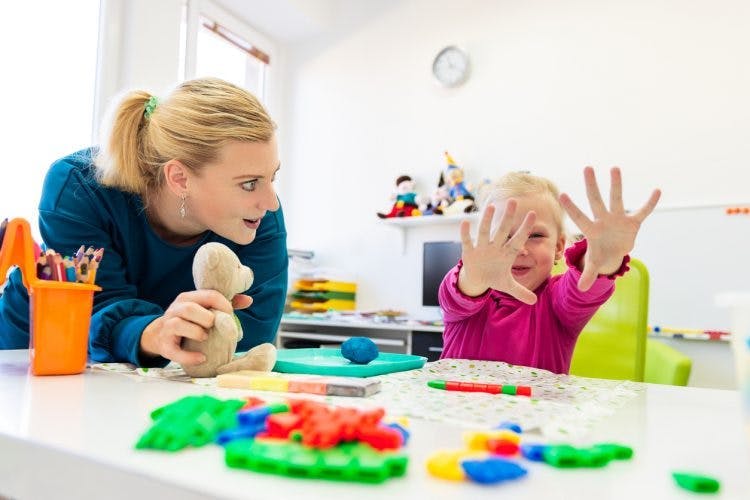No products in the cart.
No products in the cart.
No products in the cart.
No products in the cart.
Home » Neurological Recovery Blog » Cerebral Palsy » Occupational Therapy for Cerebral Palsy: Goals, Activities, and Benefits
Last updated on September 10, 2021

Occupational therapy for cerebral palsy focuses on helping individuals become as functional as possible. It primarily involves practicing activities of daily living to help individuals develop the skills necessary to optimize their independence.
To help you understand the goals and techniques used by occupational therapists to help improve mobility and boost independence in individuals with cerebral palsy, this article will discuss:
Occupational therapy is a healthcare intervention that helps individuals optimize their independence by focusing on activities of daily living.
Unlike physical therapy (which focuses on improving flexibility, range of motion, and strength through exercise), occupational therapy primarily uses practical tasks and activities to prepare individuals with cerebral palsy for everyday situations. Although some traditional exercises may still be included during an occupational therapy treatment session, they are used as a means to an end result: increased participation in a valued activity. Occupational therapy can teach individuals how to:
Cerebral palsy describes a wide range of motor impairments at varying severities caused by damage to the developing brain. Because every case of CP is unique, occupational therapy for cerebral palsy must be tailored to each individual’s specific needs. Common motor impairments observed in individuals with cerebral palsy include abnormal muscle tone, posture, balance, and coordination.
An occupational therapist will assess the individual’s strengths, weaknesses, and personal goals, and then create an individualized activity program to develop their functional independence.
Want 19 pages of CP recovery tips in PDF form? Click here to download our free illustrated ebook now (link opens a pop up for uninterrupted reading)
The following section will share examples of activities an occupational therapist may have an individual with cerebral palsy practice.

At occupational therapy, individuals with cerebral palsy will utilize a variety of interventions and approaches to enhance their functional abilities.
Some examples of activities that may be practiced in an occupational therapy session for someone with cerebral palsy include:
Unlike traditional exercise, these activities are designed to be practical and have direct, real-world application. They’re also more likely to be practiced on a regular basis, which is key to promoting adaptive changes in the brain.
Neuroplasticity is the brain’s ability to reorganize its neural circuitry so that functions affected by damage can be rewired to unaffected regions and improved. Performing task-specific and highly repetitive movements stimulates the brain, reinforces demand for those functions, and encourages the brain to make adaptive changes. As a result, the more you practice, the more natural newly developed movement patterns will start to feel.
Up next, we’ll discuss some other major benefits of participating in occupational therapy.
Learning how to perform everyday tasks independently can boost an individual’s self-esteem and confidence. This will encourage them to continue to practice the repetitions they need to promote neuroplasticity and enhance their functional abilities.
By practicing occupational therapy activities, individuals with cerebral palsy may learn how to:
Because the activities are personalized, task-specific, and practical, individuals will acquire skills that they will continue to use for the rest of their lives.
The following section will discuss how occupational therapy can be beneficial for individuals with CP at any age.

Because individuals are either born with cerebral palsy or acquire it very early in life, they often participate in occupational therapy as children. Addressing your child’s needs early on may help them learn new skills and improve their motor impairments before abnormal movement patterns and habits develop.
Additionally, children’s brains have increased levels of neuroplasticity, meaning that they absorb information and pick up new skills quicker than adult brains. Unlike adults, children with CP don’t go to occupational therapy to recover essential skills, but rather to develop them for the first time.
However, occupational therapy can also be beneficial for adults with cerebral palsy.
Although the brain damage that causes cerebral palsy will not worsen over time, the secondary effects of cerebral palsy such as spasticity and pain can. As a result, you may experience new complications as you get older.
Periodic visits to an occupational therapist can help you address these new complications as early as possible and prevent them from interfering with your functional independence.
Occupational therapy can help individuals with CP optimize their functional abilities by practicing everyday skills and activities. These activities help individuals understand the real-world application of the movements they’re practicing and how they can help them develop their independence.
We hope this article helped you understand what occupational therapy for cerebral palsy may involve and its benefits.

Get our free 19-page PDF full of helpful tips for cerebral palsy by signing up below! If you liked this article, you’ll LOVE our free ebook.
When you sign up, you’ll also receive our popular emails that share more tips for life with cerebral palsy — you can opt out anytime.
We will never sell your email address, and we never spam. That we promise.


At Flint Rehab, we understand that doing physical therapy at home can become tedious and repetitive. But when repetition is critical to recovery, it’s important to stick with a repetitive regimen. But that doesn’t mean it has to be boring.
Flint Rehab is the leading manufacturer of motion-sensing, gamified rehabilitation devices. Our bestselling recovery tool, FitMi, transforms full-body rehab exercises into an interactive experience.
See what individuals with CP are saying about FitMi:
“The FitMi and MusicGlove have done wonders for my son with hemiparesis from cerebral palsy and stroke. It motivates him to do his exercises. It does not seem like therapy for him since it is fun. FitMi monitors his progress so it is a great reinforcement for him. Music is a motivator for him. He has been using it on his arm and we will try the leg exercises soon.”
-Manning
While FitMi is a recovery tool for the full-body, our other device, MusicGlove, helps target the hand to improve fine motor skills and dexterity.
See what others have said about MusicGlove:
“My granddaughter has right-side hemiplegia from Cerebral Palsy / stroke at birth. She states that this is a great product for anyone who has issues with the use of their hand(s), and that is has helped her tremendously. She also finds the music quite catchy (surprisingly!). Our occupational therapist has been impressed as well. I can say that it has arguably been the best tool of all our therapy resources.”
-Jenni
Together, FitMi and MusicGlove make a powerful home therapy regimen for individuals with cerebral palsy. Best of all, you can save money when you bundle them together.
To learn more, click the button below:

Do you have these 19 pages of helpful tips for CP?
Get a free copy of our ebook Helpful Tips for Managing Cerebral Palsy. Click here to get instant access.
Grab a free rehab exercise ebook!
Sign up to receive a free PDF ebook with recovery exercises for stroke, traumatic brain injury, or spinal cord injury below: